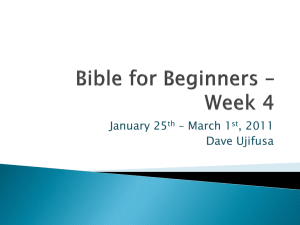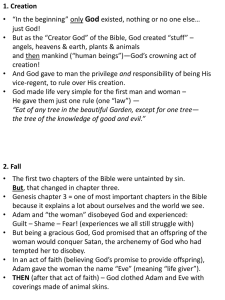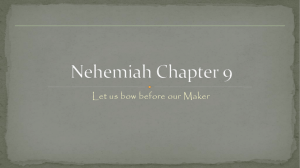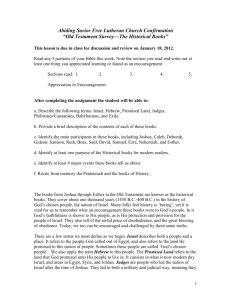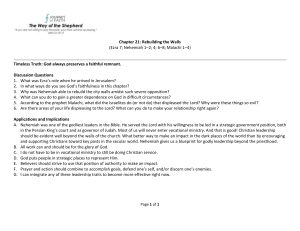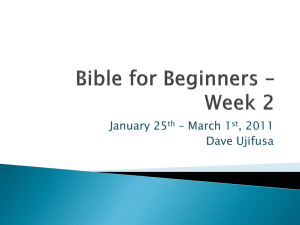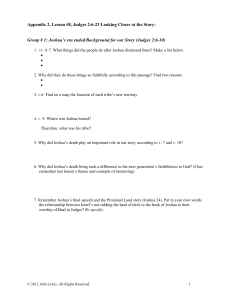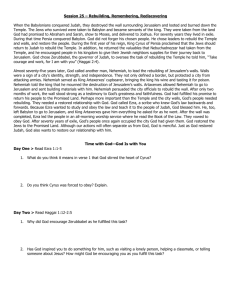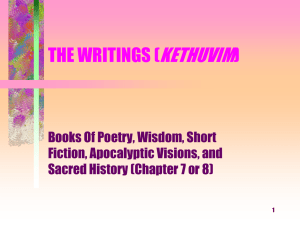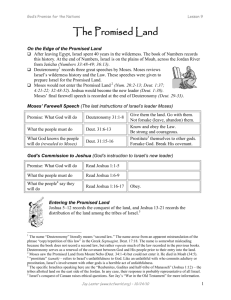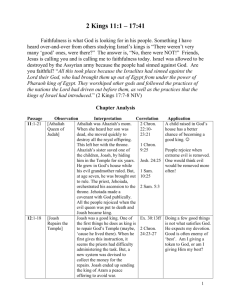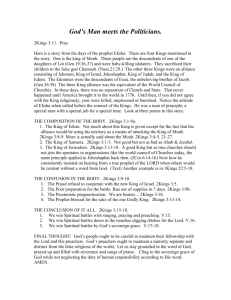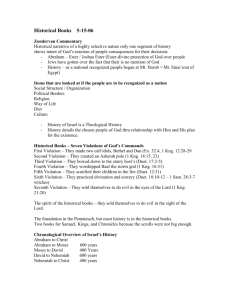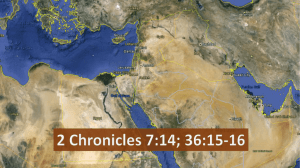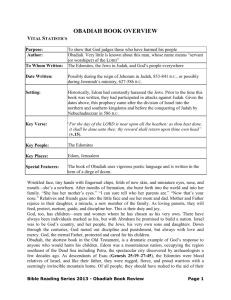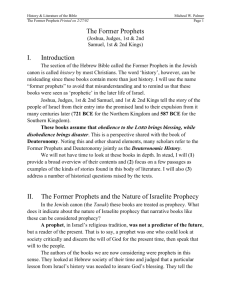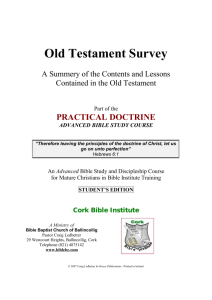Lesson 3: History - Harbour City Church
advertisement
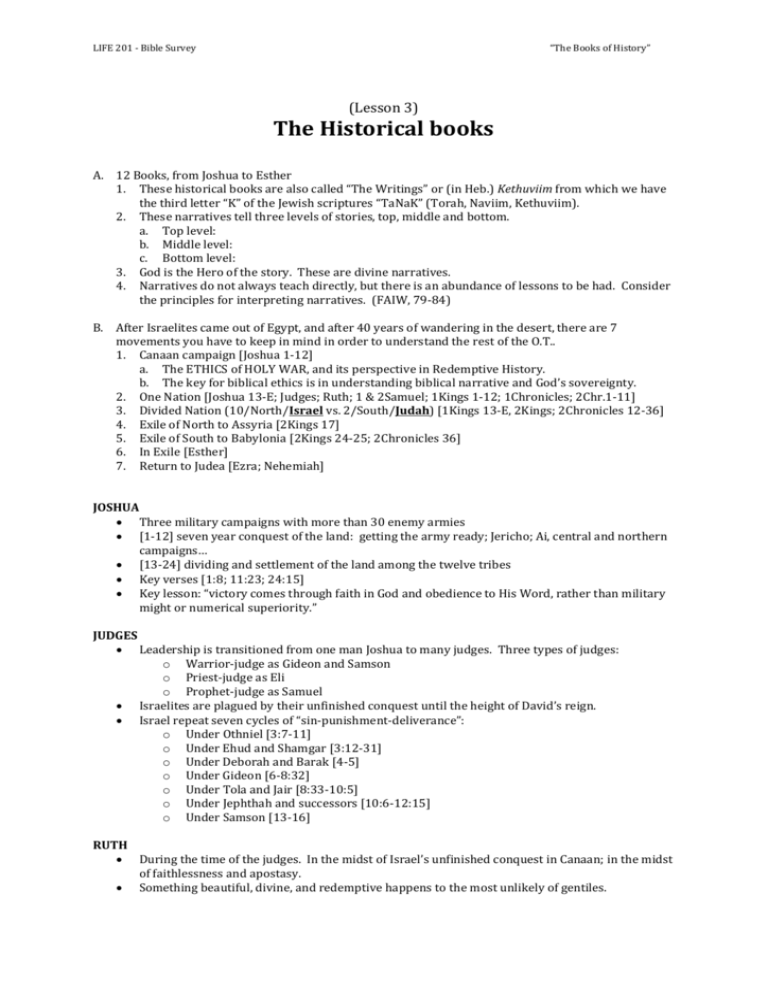
LIFE 201 - Bible Survey “The Books of History” (Lesson 3) The Historical books A. 12 Books, from Joshua to Esther 1. These historical books are also called “The Writings” or (in Heb.) Kethuviim from which we have the third letter “K” of the Jewish scriptures “TaNaK” (Torah, Naviim, Kethuviim). 2. These narratives tell three levels of stories, top, middle and bottom. a. Top level: b. Middle level: c. Bottom level: 3. God is the Hero of the story. These are divine narratives. 4. Narratives do not always teach directly, but there is an abundance of lessons to be had. Consider the principles for interpreting narratives. (FAIW, 79-84) B. After Israelites came out of Egypt, and after 40 years of wandering in the desert, there are 7 movements you have to keep in mind in order to understand the rest of the O.T.. 1. Canaan campaign [Joshua 1-12] a. The ETHICS of HOLY WAR, and its perspective in Redemptive History. b. The key for biblical ethics is in understanding biblical narrative and God’s sovereignty. 2. One Nation [Joshua 13-E; Judges; Ruth; 1 & 2Samuel; 1Kings 1-12; 1Chronicles; 2Chr.1-11] 3. Divided Nation (10/North/Israel vs. 2/South/Judah) [1Kings 13-E, 2Kings; 2Chronicles 12-36] 4. Exile of North to Assyria [2Kings 17] 5. Exile of South to Babylonia [2Kings 24-25; 2Chronicles 36] 6. In Exile [Esther] 7. Return to Judea [Ezra; Nehemiah] JOSHUA Three military campaigns with more than 30 enemy armies [1-12] seven year conquest of the land: getting the army ready; Jericho; Ai, central and northern campaigns… [13-24] dividing and settlement of the land among the twelve tribes Key verses [1:8; 11:23; 24:15] Key lesson: “victory comes through faith in God and obedience to His Word, rather than military might or numerical superiority.” JUDGES Leadership is transitioned from one man Joshua to many judges. Three types of judges: o Warrior-judge as Gideon and Samson o Priest-judge as Eli o Prophet-judge as Samuel Israelites are plagued by their unfinished conquest until the height of David’s reign. Israel repeat seven cycles of “sin-punishment-deliverance”: o Under Othniel [3:7-11] o Under Ehud and Shamgar [3:12-31] o Under Deborah and Barak [4-5] o Under Gideon [6-8:32] o Under Tola and Jair [8:33-10:5] o Under Jephthah and successors [10:6-12:15] o Under Samson [13-16] RUTH During the time of the judges. In the midst of Israel’s unfinished conquest in Canaan; in the midst of faithlessness and apostasy. Something beautiful, divine, and redemptive happens to the most unlikely of gentiles. LIFE 201 - Bible Survey “The Books of History” 1SAMUEL Story of Samuel, the Prophet-Judge Israel get’s their Kings Saul: reign [8-15], false reign and death [16-31] David anointed but waits his ascension [16-31] 2SAMUEL David’s reign as the greatest king of Israel, and the rise of Israel’s height as a nation. David’s goodness and failures 1KINGS David’s old age and death [1-2] Time of peace, Solomon’s temple building and faithlessness [3-11] Rehoboam and divided kingdom; Elijah’s ministry in Israel [12-22] 2KINGS Transition of Elijah’s ministry to Elisha [1-2] Israel spirals down until its removal [3-17] Judah also descends down to exile [18-25] 1 & 2CHRONICLES Written after Judah began to return from the Babylonian exile in 538 B.C. Focuses primarily on the history of Judah from a priestly perspective—worship! Genealogy going back to Adam [1Ch.1-9] David and Solomon [1Ch.10 – 2Ch.9] Judah’s sin which lead to exile; told as a warning to posterity; while also focusing on the good kings like Hezekiah and Josiah [2Ch.10-36]. EZRA & NEHEMIAH Both books: begin at Persia and end at Jerusalem; center around the man of God who wrote them; stories begin with a Persian king’s decree; tell of building as their chief theme; contain a long prayer of humiliation and confession (particularly in the 9 th chapter); end with purification of the people. Ezra’s keynote [7:10]; Nehemiah’s keynote [6:3] Ezra returns to Jerusalem with other captives and leads the rebuilding of the temple & worship. Nehemiah hears of the plight of the returned people and returns to rebuild the wall & morale. ESTHER The “hidden” advocacy of God Characteristics: beauty, modesty, winsome, obedient, humble, courageous, loyal and constant. Where is Jesus in the historical books of the O.T.? Where is He not?
